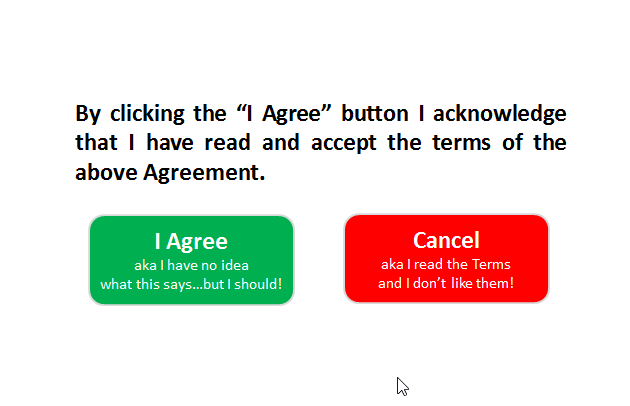Understanding the basic differences between Browse-wrap and Click-wrap Agreements
Welcome to the age of technology…where everything you do is pretty much online! You meet people online, you keep up with loved ones online, you post comments online, download software online, you purchase online, etc. For every website platform you interact with there should be some sort of Terms of Service (TOS) or Terms and Conditions (TAC) that you will have to agree to.
So yeah, that little box that you checked quickly so that you could move on and see more information, or download your favorite song, etc., that stuff is the important stuff that you just AGREED TO that NO ONE ever really reads. Well, except for maybe a few of us contract lovers and people looking for the “easter egg” of comical interruption alleged to be contained within the long winded legal mumbojumbo. Turns out, at least in my experience, those allegations are fake. Rarely do I see any humor in contracts. I know…so BORING!
There are typically two different types of agreements – the Browse-wrap and Click-wrap.
THE CLICK-WRAP AGREEMENT
The more common agreement, the click-wrap agreement (also referred to as a “clickthrough” agreement or a “clickwrap license”), is the one that I generally referenced above. It’s the agreement that actually requires you to take some sort of action, like clicking on an unmarked box, to show that you agree to the terms set forth by the website or platform. If you think about it, the website is literally placing the website’s TOS right into your hands (for reading) and asking you to acknowledge the agreement by “clicking the box” or whatever other form that assent may come in. If you want to refuse the agreement (who does that?) then one would cancel or close the window to the subject website. Courts typically uphold these kinds of agreements so remember when you are clicking you are probably entering into a legally binding contract.
THE BROWSE-WRAP AGREEMENT
Your browse-wrap agreement (also called a browserwrap or a browse-wrap license) is the other version. Generally your browse-wrap agreement is located somewhere on the website; usually seen as a hyperlink at the bottom of the page to the TOS or TAC. There is no “clicking” to manifest their agreement to the website’s terms. The idea behind this is that by a person’s mere use of the website they agree to the websites terms. Courts have been reluctant to uphold these types of agreements UNLESS the user has agreed to the terms.
BELT AND SUSPENDERS
Most websites these days, especially where they are interactive, will have BOTH a click-wrap agreement and a browse-wrap agreement tied to their website. This is done so that the website can inform users of their website’s TOS/TAC but also, for legal contracting purposes, to aid in enforce-ability of those terms. Contracts, in order to be upheld, require mutual manifestation of assent.
If you are a website owner, you want to be sure that your agreements are protecting your interests and you should consider seeking legal counsel on the matter if you have any questions. Beebe Law, PLLC is an Arizona based law firm representing clients in the state of Arizona.

